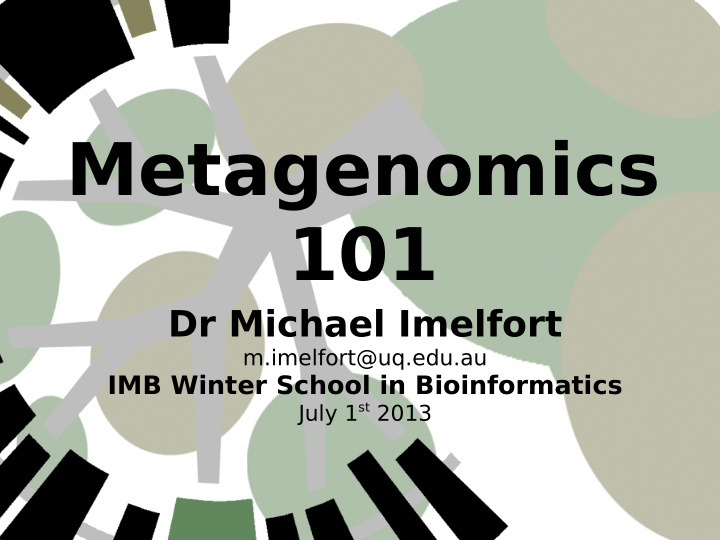



Metagenomics 101 Dr Michael Imelfort m.imelfort@uq.edu.au IMB Winter School in Bioinformatics July 1 st 2013
What is Metagenomics? → typically involves microbes → typically uses next gen → is new* → is an open problem → is difficult to do well → is very interesting
16S rRNA “deep” pyrotagging metagenomics
Volume Resolution
16S rRNA pyrotagging Exploits conserved Vs unconserved regions in 16S subunit “Roll call” Semi-quantitative ● Multiple copies of 16S ● Multiple copies of chromosomes Inexpensive (relatively) Approximate ● 97% identity → species / genus Established (1970s)
Deep Metagenomics DNA extraction - Natural environments - Contamination and sequencing - Low amounts of DNA Assembly - Wildly different coverage levels (including QA) - Strain heterogeneity - GroopM - Coverage Binning - ESOM - Kmers - T axonomic assignment / Genome trees Analysis - Annotation - Metabolomic reconstruction - Population / community dynamics
Case study - ANME2D
Case study - ANME2D Nitrogen removal (de nitrification) addition of methanol → $$$ produces methane → greenhouse gas There is some evidence to show that certain microbial populations can couple methane oxidisation (AOM) to nitrate reduction WHO? HOW?
Enrichment
16S rRNA + FISH
Assembly and binning
The evidence Abundance data ( 16S rRNA ) + full methanogenesis pathway + metatranscriptomic data + process data + metrics + isotope labelling The data 16S rRNA: 454 Metagenome: Illumina HiSeq (1 lane PE) IonT orrent PGM (MP) Metatranscriptome: Illumina MiSeq IonT orrent PGM What next..?
Next...
Microbes are awesome Postdoc / Phd / Masters / Honours Bioinformatics and metagenomics Soil, engineered, Human, agricultural and marine systems. Whole community analysis and single amplified genomes. Tree of life, assembly, binning, annotation, more... Contact: Professor Phil Hugenholtz: p.hugenholtz@uq.edu.au Dr Gene Tyson: g.tyson@uq.edu.au Dr Michael Imelfort: m.imelfort@uq.edu.au www.ecogenomic.org
?
Recommend
More recommend